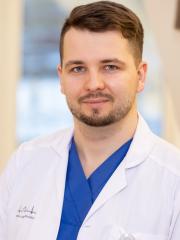Radiological examinations of the heart
The Centre of Cardiology, in cooperation with radiologists, performs several studies for detecting cardiovascular diseases. A cardiologist can refer the patient to these examinations.
Computed tomography angiography of the heart with a contrast agent - a radiological examination method to obtain layered and three-dimensional images of the heart. The aim of the examination is to evaluate the anatomy of the coronary arteries, heart chambers, heart valves and large blood vessels (aorta and pulmonary artery). The amount of radiation used during the examination is greater than in a normal X-ray examination. During the examination, the patient lies on an examination table that slowly moves back and forth in a tunnel-like device while the patient's vital signs are monitored. The examination uses a contrast agent that contains iodine, so the examination is not suitable for those with a known allergy to iodine. The length of the examination is usually 10-15 minutes. The examination is mostly used with those patients who are at higher risk for developing a coronary artery disease, have signs of a coronary artery disease or are suspected to have a narrowing in the blood vessels due to atherosclerosis. If CT angiography of the heart indicates significant narrowing in the coronary arteries, an invasive examination of the blood vessels of the heart – coronary angiography – is usually performed for the final diagnosis of ischemic heart disease.
Cardiac computed tomography-angiography stress test - during the test, a special drug called adenosine or regadenoson, which is a selective coronary vasodilator, is used to assess ischemia.
Since a specific drug is used to expand the blood vessels of the heart, 24 hours before coming for the examination the patient must not:
- Consume drinks containing caffeine: coffee, tea, energy drinks, Coca Cola, Pepsi Cola
- Eat chocolate or chocolate products
- Smoke
Magnetic resonance imaging of the heart with a contrast agent - a diagnostic examination that uses a magnetic field to obtain an image and enables the assessment of the anatomy of different parts of the heart (heart chambers, heart valves, heart muscle) and blood vessels. MRI makes it possible to diagnose ischemia of the heart muscle, inflammation of the heart muscle, heart tumours, as well as diseases of the pericardium and congenital heart defects. MRI is sometimes used to evaluate heart structures before planned medical procedures – for example, before ablation therapy for arrhythmias. The examination lasts for 15-60 minutes. This examination uses the contrast agent gadolinium, which does not contain iodine, so the examination can also be scheduled for those who have an allergy to iodine. No metal objects or mechanical devices may be brought into the examination room. For those patients who have a pacemaker, the pacemaker is placed in an appropriate operating mode for the duration of the MRI scan, and the previous operating program is restored after the scan. It is necessary to inform your doctor about other metal foreign bodies in your body. The doctor will then explain whether an MRI examination can be performed. The examination lasts for 60 minutes.
Cardiac magnetic resonance imaging stress test - the examination is similar to the one mentioned above. During the test, a special drug called adenosine or regadenoson, which is a selective coronary
Since a specific drug is used to expand the blood vessels of the heart, 24 hours before coming for the examination the patient must not:
- Consume drinks containing caffeine: coffee, tea, energy drinks, Coca Cola, Pepsi Cola
- Eat chocolate or chocolate products
- Smoke
Myocardial scintigraphy - SPECT examination - the test evaluates the blood supply to the heart before and after a pharmacological stress test. For this purpose, the special drug regadenoson (Rapiscan) is used, which is a selective vasodilator of the coronary arteries. The doses of radioactive radiation used in the examination are relatively small. The whole-body dose to the patient obtained from one examination is about 3-10 times lower than the dose of ionising radiation obtained from coronary angiography (CA), i.e. cardiac catheterisation. The SPECT examination is used in the diagnosis of coronary heart disease.
Since a specific drug is used to expand the blood vessels of the heart, 24 hours before coming for the examination the patient must not:
- Consume drinks containing caffeine: coffee, tea, energy drinks, Coca Cola, Pepsi Cola
- Eat chocolate or chocolate products
- Smoke
Coronary angiography (CA) - diagnostic examination, more widely known as cardiac catheterisation. The purpose of the coronary angiography is to assess possible narrowing or stenoses of the coronary arteries of the heart. If the narrowings found are extensive, and if necessary and technically suitable, as a follow-up to the diagnostic coronary angiography a treatment procedure can be performed, which is the expansion of the heart's blood vessels using a balloon and stenting, i.e. coronary angioplasty – if, based on the findings of heart catheterisation or selective coronary angiography (SCA), the heart's blood vessels have been significantly damaged, which is why they have decreased their diameter and impaired blood supply to the heart, the treatment procedure can be continued through the catheter. If technically suitable, a blood vessel of the heart can be expanded. This procedure is called percutaneous coronary intervention (PCI). In most cases, a coronary stent – a tubular mesh to support the enlarged part of the blood vessel – is installed to confirm the result of PCI.
 Terviseportaal
Terviseportaal
